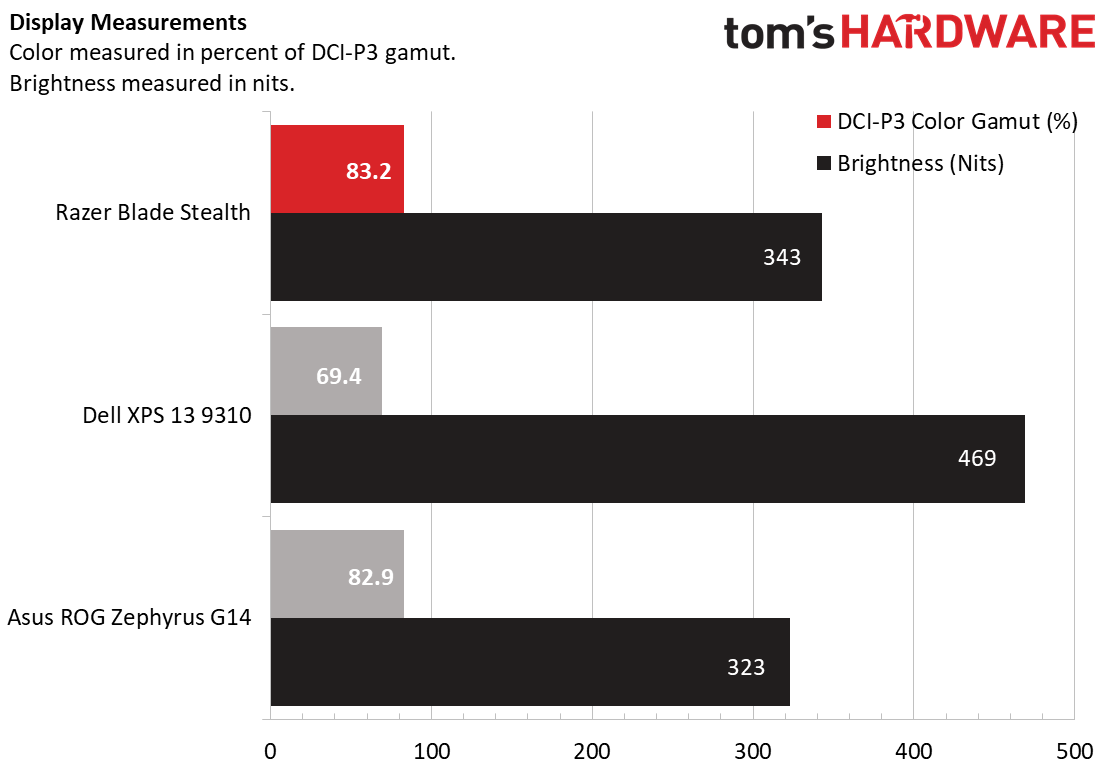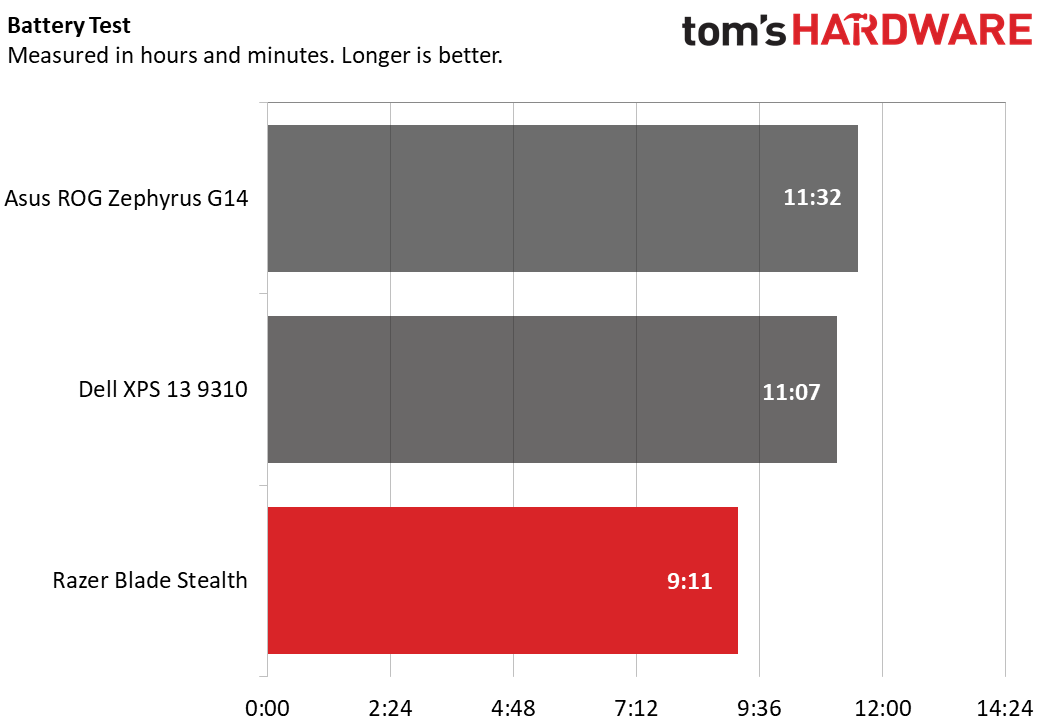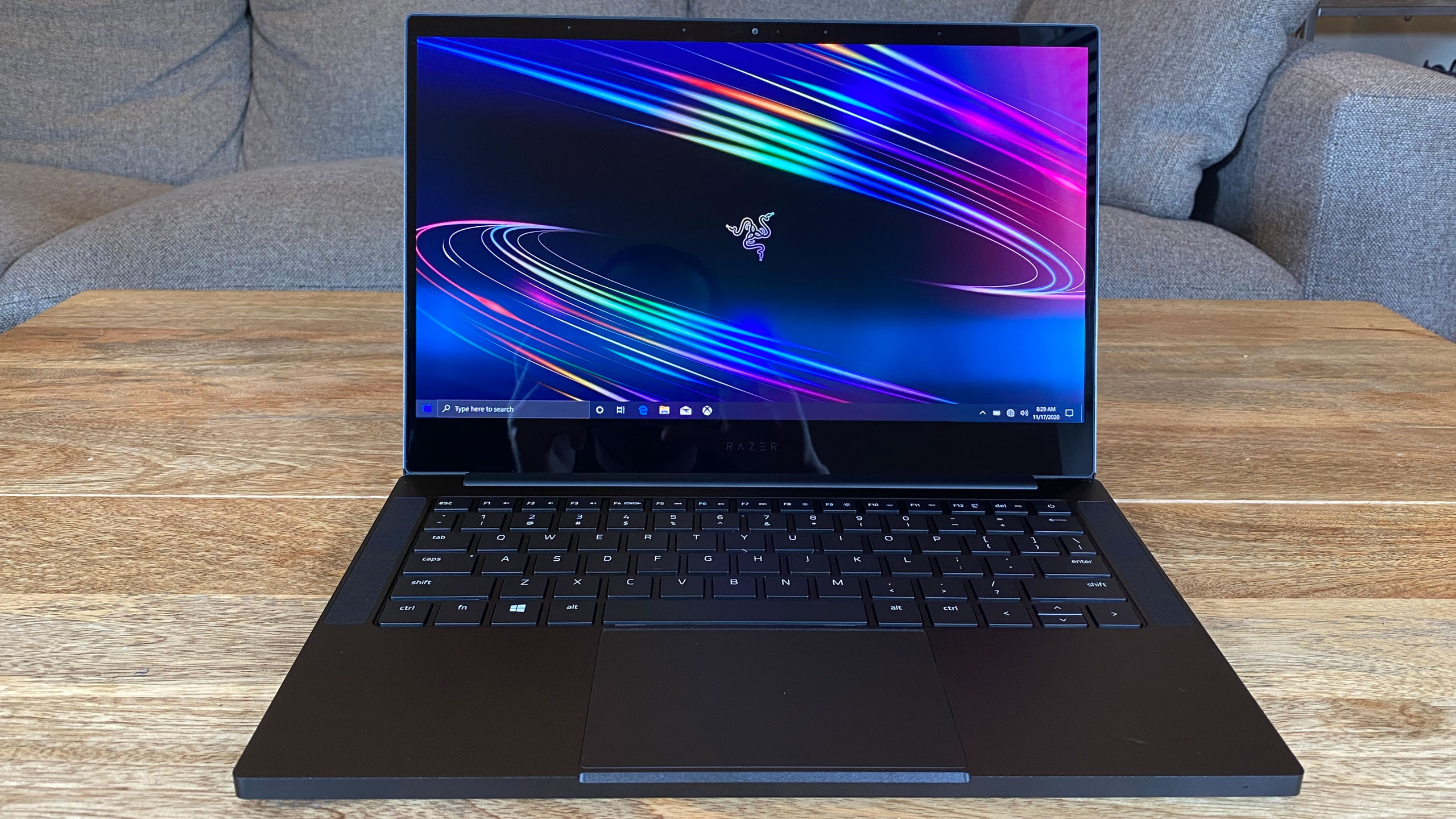Tom's Hardware Verdict
The Razer Blade Stealth is confused about what it wants to be. It's priced as a premium ultraportable and looks like one too. But as a gaming notebook, it's quite underpowered for the price. While the OLED screen is beautiful, Razer needs to work on the keyboard.
Pros
- +
Great build quality
- +
OLED screen is gorgeous
- +
Thunderbolt 4 on both sides
Cons
- -
Cheaper gaming laptops offer better graphics
- -
Uncomfortable keyboard
Why you can trust Tom's Hardware
There are a few things I can say with certainty about the Razer Blade Stealth ($1,799.99 to start, $1,999.99 as tested). For one thing, it's built like a tank. Our option had a beautiful OLED display, and Razer doesn't heap on bloatware.
What I can't tell you, though, is who this laptop is for exactly. Razer calls it a "gaming ultraportable," and prices it among the best ultrabooks, which are often expensive partially due to build quality. But the mix of an Intel Core i7-1165G7 and Nvidia GeForce GTX 1650 Ti, while they can play eSports games or AAA games, are low-end for a laptop of this price. Competing gaming notebooks with far superior graphics performance can be found for less money. To make it more confusing, Razer has announced the Razer Book 13, a non-gaming ultraportable that houses Intel’s Xe integrated graphics.
Among competing ultrabooks, the best gaming laptops and in Razer's own stack, the Blade Stealth feels more niche than it used to. And yet, somehow, it still gets plenty right.
Design of the Razer Blade Stealth

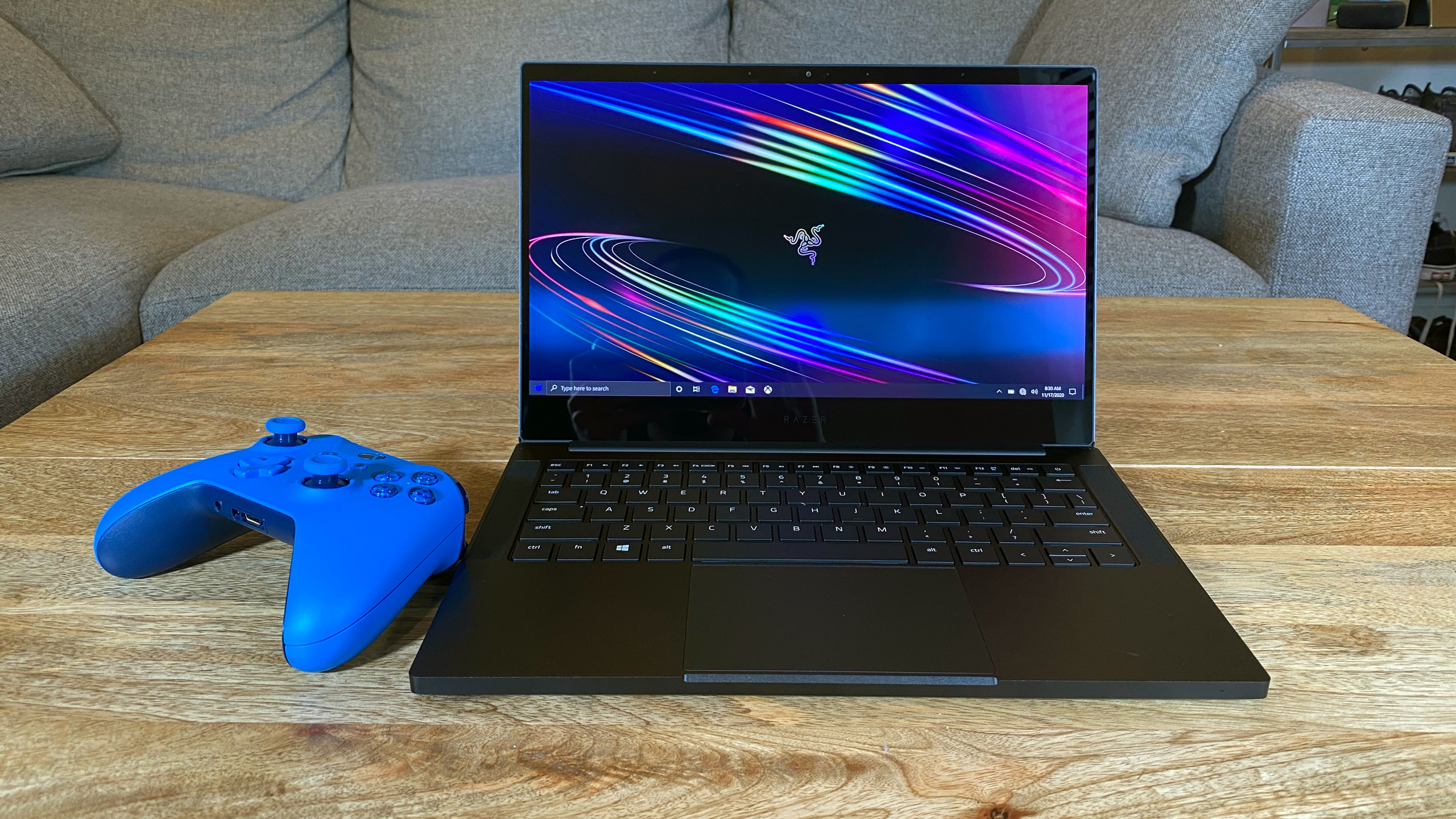
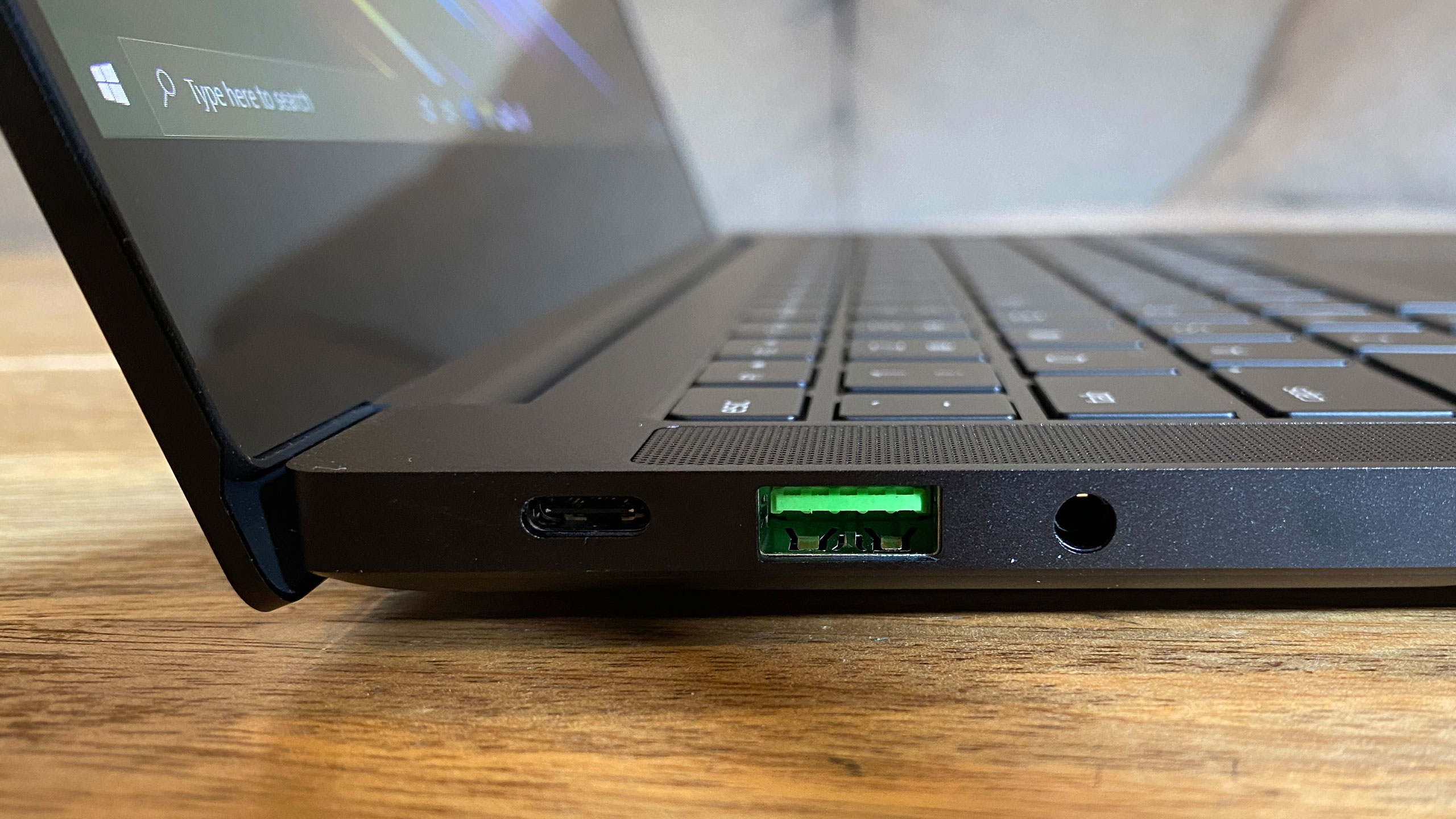
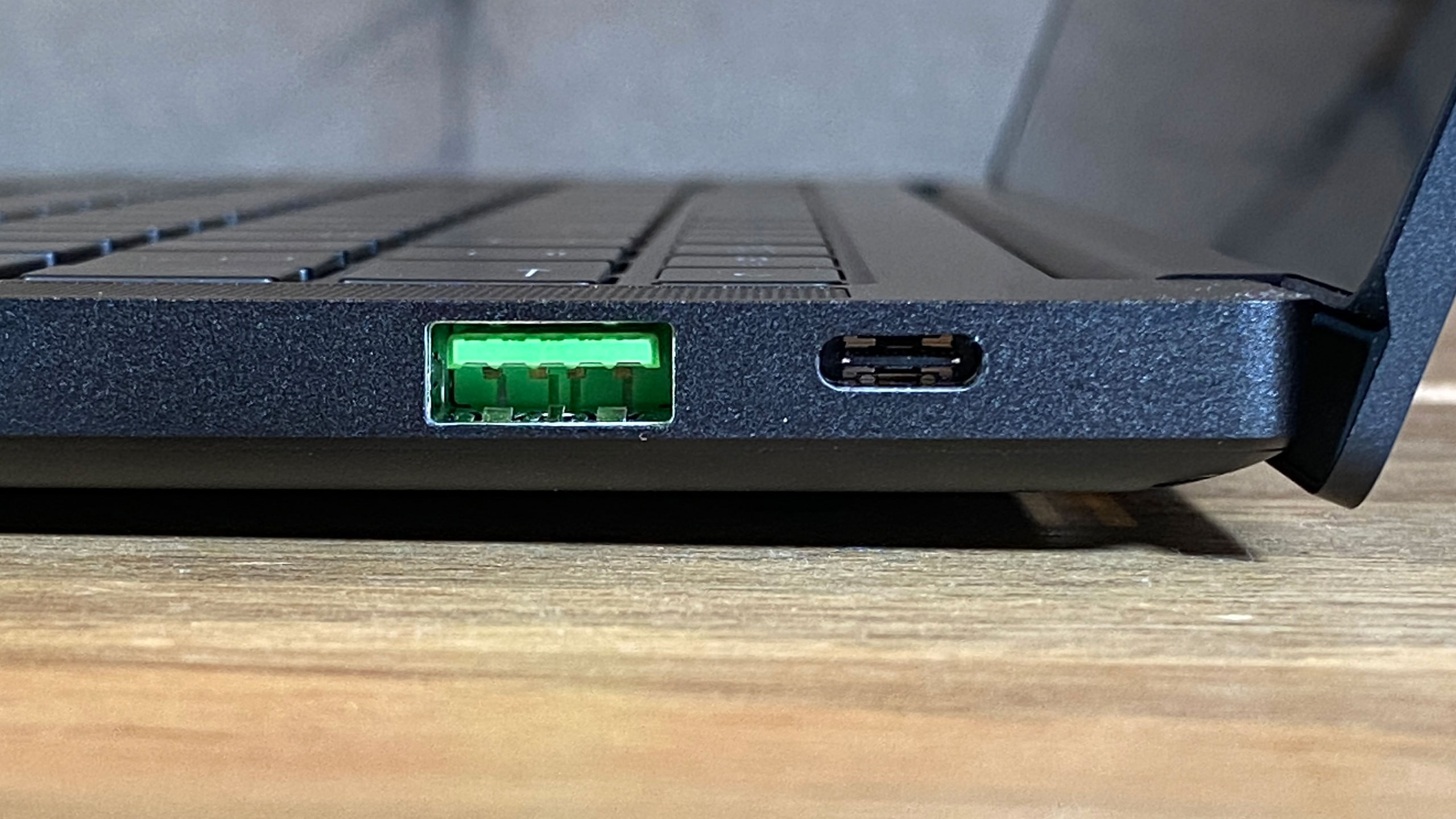
We last reviewed the Razer Blade Stealth in September with a 10th Gen Intel Ice Lake processor, and the design hasn't changed a bit in the intervening two months. But for those who aren't familiar with it, the Stealth is a black aluminum notebook. The lid features the Razer tri-headed snake logo, but at least the company made it black on black, so you can mostly ignore it if it doesn’t fit your style.
The no-frills aluminum build continues when you unfold the laptop. It's all-black aluminum on the deck, with speakers flanking both sides of the keyboard. That's the one spot with some color, as the keys are lit with single-zone Chroma RGB. The display is surrounded by a moderate, but inoffensive, bezel.
The left side of the laptop has a Thunderbolt 4 port over USB Type-C, USB 3.1 Gen 1 Type-A and a headphone jack. The right side is the same, minus the headphone jack. I do appreciate that Razer has the ports evenly distributed across the laptop, and you can charge on either side via the Thunderbolt ports.
If you consider the Stealth to be a gaming notebook, it's small at 3.1 pounds and 12 x 8.3 x 0.6 inches. The Asus ROG Zephyrus G14, a 14-inch gaming notebook, is 3.5 pounds and 12.8 x 8.7 x 0.7 inches, and even that's petite for a gaming notebook.
But if the Blade Stealth is an ultraportable, then it's big. The Dell XPS 13 9310 is 2.8 pounds and 11.6 x 7.8 x 0.6 inches, though it does have fewer ports.
Razer Blade Stealth Specifications
| CPU | Intel Core i7-1165G7 |
| Graphics | Nvidia GeForce GTX 1650 Ti Max-Q (4GB), Intel Iris Xe Graphics (integrated) |
| Memory | 16GB LPDDR4X-4266 |
| Storage | 512GB PCIe NVMe SSD |
| Display | 13.3-inch, 1920 x 1080, OLED, touch |
| Networking | 802.11ax Intel Wi-Fi 6 |
| Ports | 2x USB 3.1 Gen 1 Type-A, 2x Thunderbolt 4, 3.5 mm headphone/mic jack |
| Camera | 720p IR |
| Battery | 53.1 WHr |
| Power Adapter | 100 W |
| Operating System | Windows 10 Home |
| Dimensions(WxDxH) | 12 x 8.3 x 0.6 inches / 304.6 x 210 x 15.3 mm |
| Weight | 3.1 pounds / 1.4 kg |
| Price (as configured) | $1,999.99 |
Gaming and Graphics on the Razer Blade Stealth
The Razer Blade Stealth comes with an Nvidia GeForce GTX 1650 Ti for gaming. To put it flatly, that's not going to get you strong performance outside of some eSports titles, unless you're willing to bring down your settings.
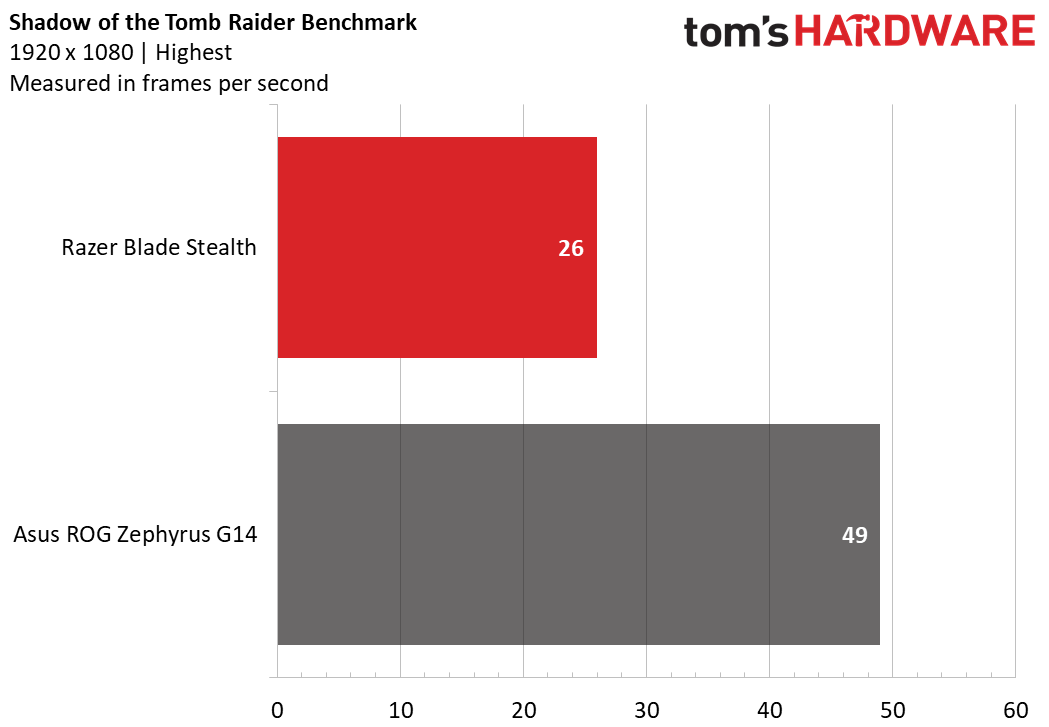
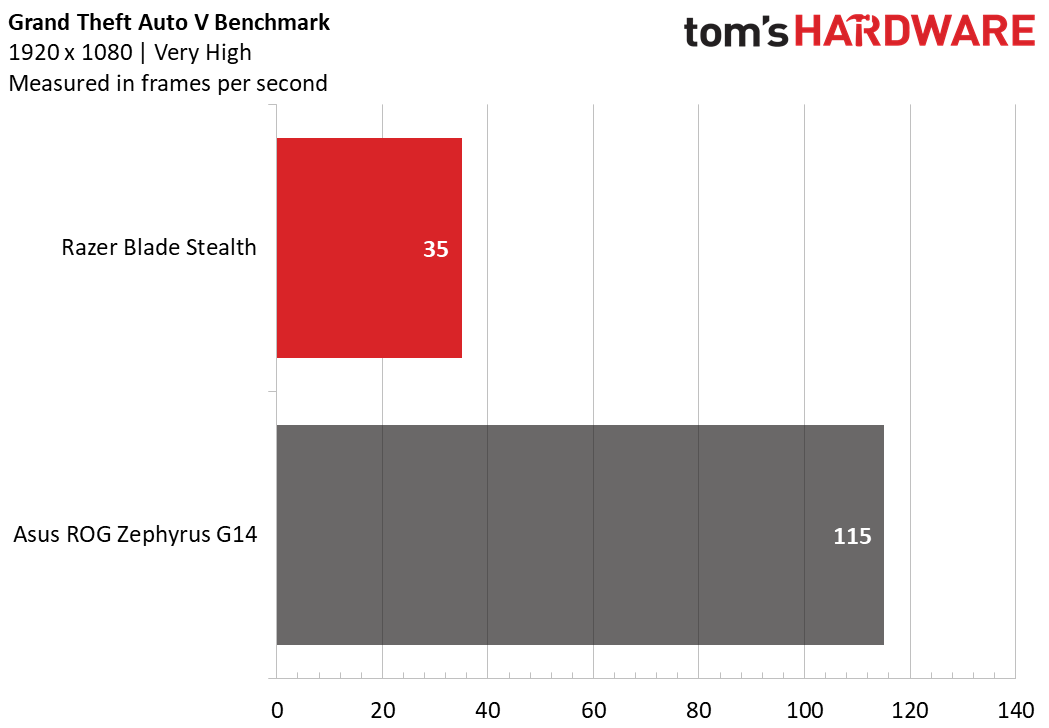


I tested out the Stealth playing a few rounds of Rocket League, an eSports title that's matches the type of game one should most expect to play on this laptop. In a round, I saw frames fluctuate between 177 and 202 frames per second (fps) on high quality mode at 1080p resolution. Since our review unit's screen only has a 60 Hz refresh rate, it really would have made sense to limit the frames.
Get Tom's Hardware's best news and in-depth reviews, straight to your inbox.
You may notice that our primary competitor in gaming, the Asus Zephyrus G14, has a much better GPU: an Nvidia GeForce RTX 2060 Max-Q. This isn't an accident -- you can get that machine for $1,449, which is cheaper than the Blade Stealth we're reviewing. What the Stealth offers is better than the integrated graphics you get in most ultraportables, but other, cheaper gaming laptops do offer more power.
On the Shadow of the Tomb Raider benchmark, on the highest settings at 1080p, the Stealth ran the game at 26 fps, which is below our 30 fps playable threshold, while the Zephyrus G14 hit 49 fps. Red Dead Redemption 2, at medium settings and 1080p, was also unplayable at 22 fps, while the Zephyrus G14 hit 35 fps.
On Grand Theft Auto V, at very high settings at 1080p, the Stealth played at 35 fps, but the Zephyrus G14 hit 115 fps.
The Blade managed to play Far Cry New Dawn (1080p, ultra) at 47 fps, but the Zephyrus beat it again at 73 fps.
To stress-test the Blade Stealth, we ran the Metro Exodus benchmark 15 times on a loop, which simulates about half an hour of gameplay. On the high preset, the game ran at an average of 29.9 fps, suggesting that you really need to drop down to normal or lower for playable frame rates. It hit 30 fps the first two runs before dropping down to around 29.9 for the rest of the gauntlet.
During that test, the CPU measured an average clock speed of 3.5 GHz and an average temperature of 60.8 degrees Celsius (141.4 degrees Fahrenheit). The GPU ran at an average speed of 1,287.6 MHz and an average temperature of 57.2 degrees Celsius (135 degrees Fahrenheit).
Productivity Performance on the Razer Blade Stealth
We tested the Razer Blade Stealth with an Intel Core i7-1165G7 CPU, 16GB of LPDDR4X RAM and a 512GB PCIe NVMe SSD. The package is a formidable workhorse, though other machines in both the gaming and ultraportable space do have some advantage.

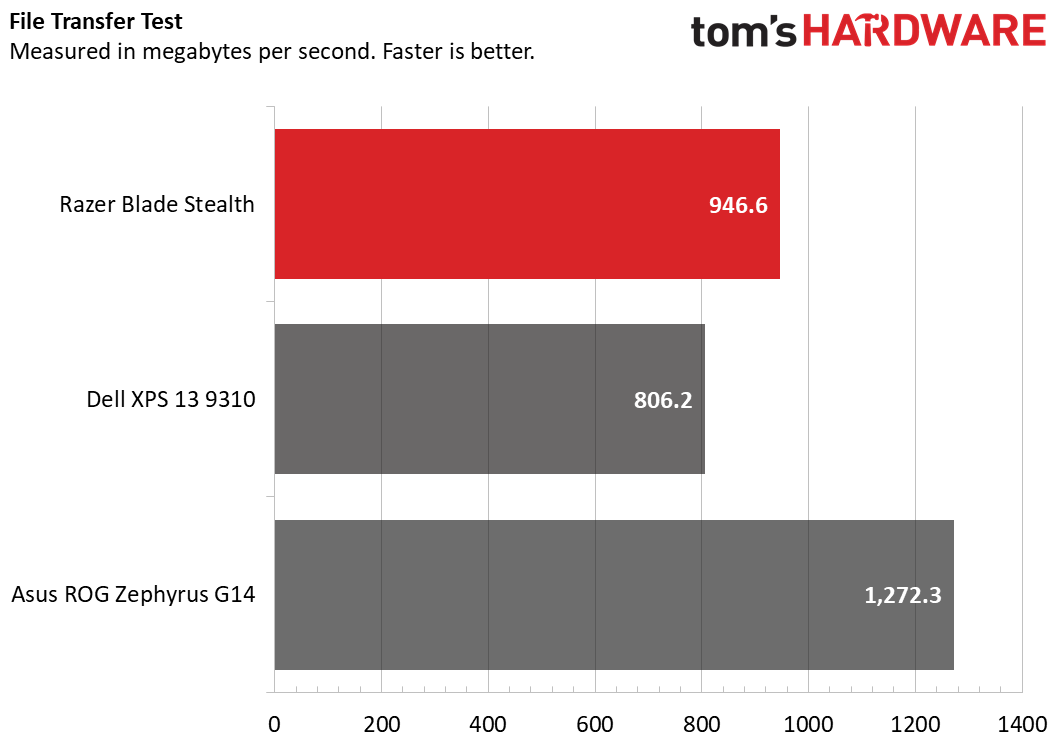
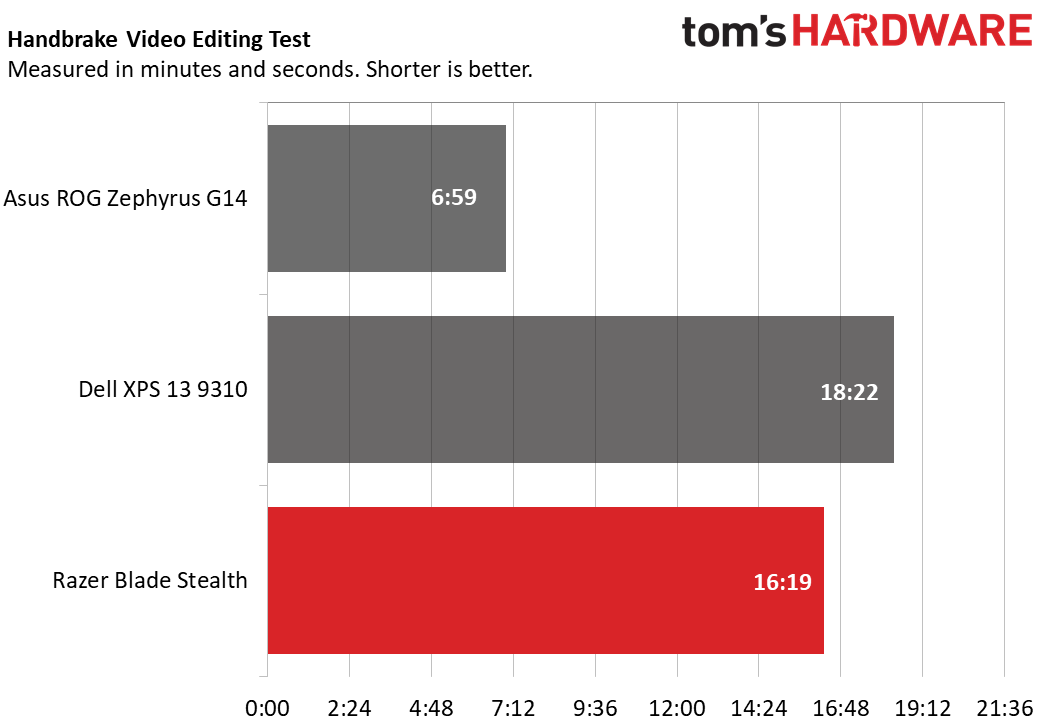
On Geekbench 5.0, the Stealth earned a multi-core score of 4,992, falling to the XPS 13 (also with a Core i7-1165G7) and the Asus ROG Zephyrus G14, a gaming machine with an AMD Ryzen 9 4900HS.
The Blade Stealth copied 4.97GB of files at a rate 946.6 MBps, beating the XPS 13 9310 but still slower than the Zephyrus.
On our Handbrake test, Razer's laptop took 16 minutes and 19 seconds to transcode a 4K resolution video to 1080p. That's faster than the XPS 13, but the Zephyrus smashed it in less than half that time.
Display on the Razer Blade Stealth
The 13.3-inch FHD OLED touchscreen on the Stealth sure looks nice. The trailer for Black Widow (is it ever going to come out?) looked excellent. When the titular heroine is surrounded by flames in a car chase with Taskmaster, the orange reflections really stood out on a dark road. The villain's navy suit contrasted with Red Guardian's, well, red, knockoff Captain America outfit. In Rocket League, the Blade Stealth's screen made the orange and blue cars pop against green turf.
Razer's panel covers 83.2% of the DCI-P3 color gamut, just a smidge higher than the Zephryus' display. The XPS 13 covers 69.4%.
The Blade Stealth measured an average brightness of 343 nits, while the XPS 13 was the brightest of the bunch at 469 nits. The Zephyrus G14 was a tad behind at 323 nits.
Keyboard and Touchpad on the Razer Blade Stealth

Earlier this year, Razer fixed a long-maligned keyboard layout that put the shift key in an awkward place. That's a major improvement, and the next step should be to focus on key travel. The keys have soft switches, and I had a tendency to bottom out on the aluminum frame, which tired my fingers. As I got used to the keyboard, I hit 112 words per minute with my usual error rate, which isn't bad, but I could've felt a bit better doing it with more travel.
It wouldn't be a Razer device without Chroma RGB lighting. The keyboard is single-zone backlit and can be controlled via the Synapse software.
The 4.3 x 3-inch touchpad is tall, making it more spacious than much of the Windows competition (though it's still not as luxuriously large as what you see on Apple's MacBooks). Windows Precision drivers ensure accurate scrolling and gestures. This is definitely one of the best touchpads on a Windows 10 laptop.
Audio on the Razer Blade Stealth
I'll give the Blade Stealth’s audio this: It gets loud. The twin top-firing speakers immediately filled up my apartment with sound -- in fact, I found it uncomfortable at maximum volume. When I listened to Blackway and Black Caviar's "What's Up Danger," I got the best results with audio around 85%. The audio was clear, with vocals mixing well with sirens and synths in the background, as well as some drums. Bass, however, was lackluster. In Rocket League, car motors and bouncing balls were all clear.
Of the little software pre-installed on the system, one you might want to check out is THX Spatial Audio. Switching between stereo and spatial audio didn't make a huge difference, but there are some presets, including games, music and voice to toggle between.
Upgradeability of the Razer Blade Stealth
Ten Torx screws hold the bottom of the Razer Blade Stealth's chassis to the rest of the system. I used a Torx T5 screwdriver to remove them, and the bottom came off without much of a fight.
The SSD is immediately accessible, and the Wi-Fi card and battery are also easily available for upgrades. The RAM, on the other hand, is soldered onto the motherboard.
Battery Life on the Razer Blade Stealth
The Razer Blade Stealth's history with battery life has been mixed, but this iteration with Intel's 11th Gen Core processors is decent, especially considering it has a discrete GPU. The laptop ran for 9 hours and 11 minutes on our battery test, which continuously browses the web, run OpenGL tests and streams video over a Wi-Fi connection, all at 150 nits of brightness.
But ithe Razer was outclassed by both the Dell XPS 13 (11:07) and the Zephyrus G14, the longest-lasting gaming notebook we've ever seen (11:32), so there's still room for improvement on Razer's part.
Heat on the Razer Blade Stealth
Since Razer classifies the Blade Stealth as a "gaming ultraportable," we took our heat measurements by pushing it to the limits on our Metro Exodus test.
During the benchmark, the keyboard between the G and H keys measured 42.7 degrees Celsius (108.9 degrees Fahrenheit), while the touchpad was cooler at 30.9 degrees Celsius (87.6 degrees Fahrenheit).
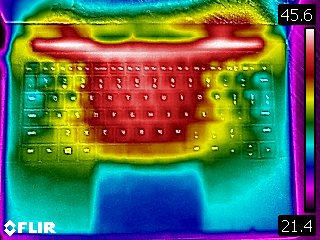

The hottest point on the bottom of the laptop reached 47.3 degrees Celsius (117.1 degrees Fahrenheit).
Webcam on the Razer Blade Stealth
Above the display, the Razer Blade Stealth has a 720p resolution webcam with infrared (IR) sensors. The IR sensors let you use facial recognition to log in to Windows 10 with Windows Hello, which was quick and accurate.
The webcam is passable. It caught details about as fine as a 720p webcam can, like hairs on my head, but the picture was still a little grainy and could definitely be sharper. On a laptop that has so many of the little details right, I'm ready for an upgrade on the camera.
Software and Warranty on the Razer Blade Stealth
You won't spend much time removing bloatware from the Stealth. The only major piece of software that Razer adds to Windows 10 is Synapse, its hub for Chroma RGB lighting, adjusting performance modes, registering products and syncing accessories.
Windows 10 comes with some bloatware of its own, including Roblox, Hulu, Hidden City: Hidden Object Adventure, Spotify and Dolby Access.
Razer sells the Blade Stealth with a one-year warranty.
Razer Blade Stealth Configurations
We reviewed the $1,999.99 top-end variant of the Stealth, with an Intel Core i7-1165G7, Nvidia GeForce GTX 1650 Ti, 16GB of RAM, a 512GB SSD and a 13.3-inch OLED FHD touchscreen.
I suspect that those who are using this system primarily for gaming will prefer the $1,799.99 base model, which has all of the same parts except for the display, which is a 120 Hz FHD screen.
Bottom Line
The Razer Blade Stealth does a lot right, with great build quality, a lovely OLED screen and symmetrical Thunderbolt 4 ports for convenient charging on either side of the system.
If you're buying this as an ultraportable, it's expensive at $1,999.99 (with the OLED screen, anyway). But if you're buying it as a gaming notebook, you should look elsewhere to save money and get better performance. The Asus Zephyrus G14 gives you the best Ryzen mobile processor for gaming around and has an RTX 2060 Max-Q for $450 less at $1,449.99. It doesn't have Razer's build quality or an OLED option, but it's a worthwhile tradeoff in performance and you still get a 120 Hz display.
Razer doesn't offer a version of the Stealth without the GTX 1650 Ti. That's saved for the new Razer Book 13, which we haven't reviewed yet as of this writing. But with that notebook in the wings, and the excellent Razer Blade 15 Advanced on the other side of Razer's lineup, it makes a lot of sense to either spend more for better parts for gaming or spend less for better parts for productivity.
Those who just want to mix in some casual eSports play with work will get what they need out of this laptop, but a high-priced eSports laptop is a bit of a niche. While the Stealth is still a decent laptop, it doesn't make as much sense as it used to.

Andrew E. Freedman is a senior editor at Tom's Hardware focusing on laptops, desktops and gaming. He also keeps up with the latest news. A lover of all things gaming and tech, his previous work has shown up in Tom's Guide, Laptop Mag, Kotaku, PCMag and Complex, among others. Follow him on Threads @FreedmanAE and BlueSky @andrewfreedman.net. You can send him tips on Signal: andrewfreedman.01
-
kevparker The Razer Blade Stealth 2020 is great, I bought it last week, and it's incredible. Online Shopping Sri LankaReply
